Arcadyan Technology 7904WBRA-N Draft 11n Wireless 4-Port Annex A ADSL2/2 Router User Manual 00
Arcadyan Technology Corporation Draft 11n Wireless 4-Port Annex A ADSL2/2 Router 00
Contents
- 1. Manual 1
- 2. Manual 2
Manual 2

C
ONFIGURING
THE
B
ARRICADE
4-26
1483 Routing
Confirm Password Confirm password
MTU Leave the Maximum Transmission Unit (MTU) at the default
value unless instructed by your ISP
Parameter Description
IP Address Enter the IP address provided by your ISP.
Subnet Mask Enter the subnet mask address provided by your ISP.
Default Gateway Enter the gateway address provided by your ISP.
VPI/VCI Enter the Virtual Path Identifier (VPI) and Virtual
Circuit Identifier (VCI) supplied by your ISP.
Encapsulation Select the encapsulation used by ISP from the drop
down list.
QoS Class ATM QoS classes including CBR, UBR and VBR
PCR/SCR/MBS QoS Parameters - PCR, SCR and MBS are configurable.
DHCP Client Check the box if your ISP assigns an IP address
dynamically.
Parameter Description
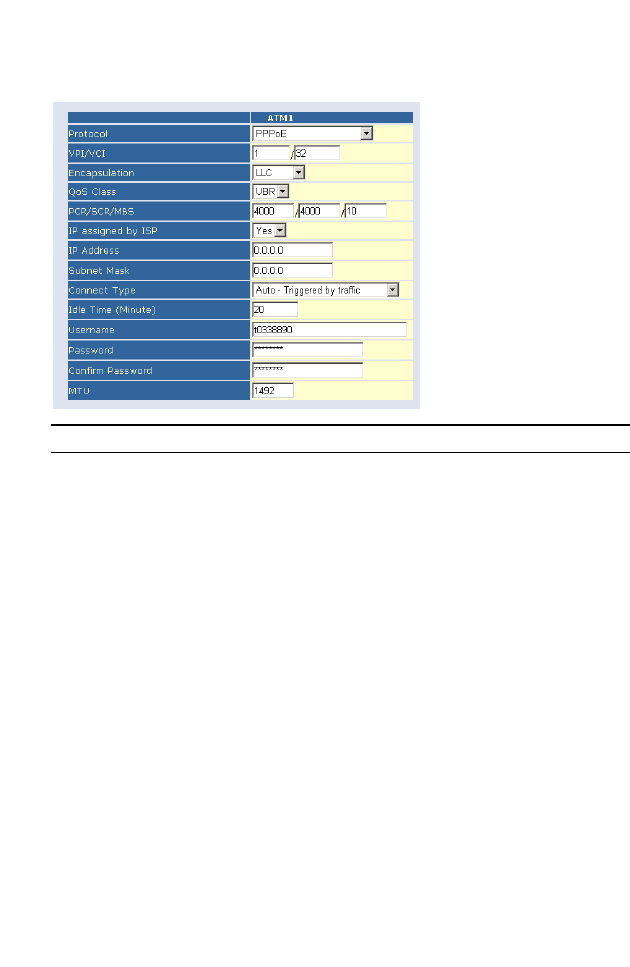
C
ONFIGURATION
PARAMETERS
4-27
PPPoE
Parameter Description
VPI/VCI Enter the Virtual Path Identifier (VPI) and Virtual Circuit
Identifier (VCI) supplied by your ISP.
Encapsulation Select the encapsulation used by ISP from the drop-down
menu.
QoS Class ATM QoS classes including CBR, UBR and VBR
PCR/SCR/MBS QoS Parameters - PCR, SCR and MBS are configurable.
IP assigned by ISP Select yes, if your ISP assigns IP address dynamically.
IP Address If you have selected “No” in the previous field, type in
the IP address provided by your ISP.
Subnet Mask Enter the subnet mask address provided by your ISP.
Connect Type Sets connection mode to Always connected,
Auto-Triggered by traffic or Manual connection. For flat
rate services use Always connected.
Idle Time
(Minute)
Enter the maximum idle time for the Internet
connection. After this time has been exceeded the
connection will be terminated. This setting only applies
when the Connect Type is set to Auto-Triggered by
traffic.
Username Enter user name.
Password Enter password.
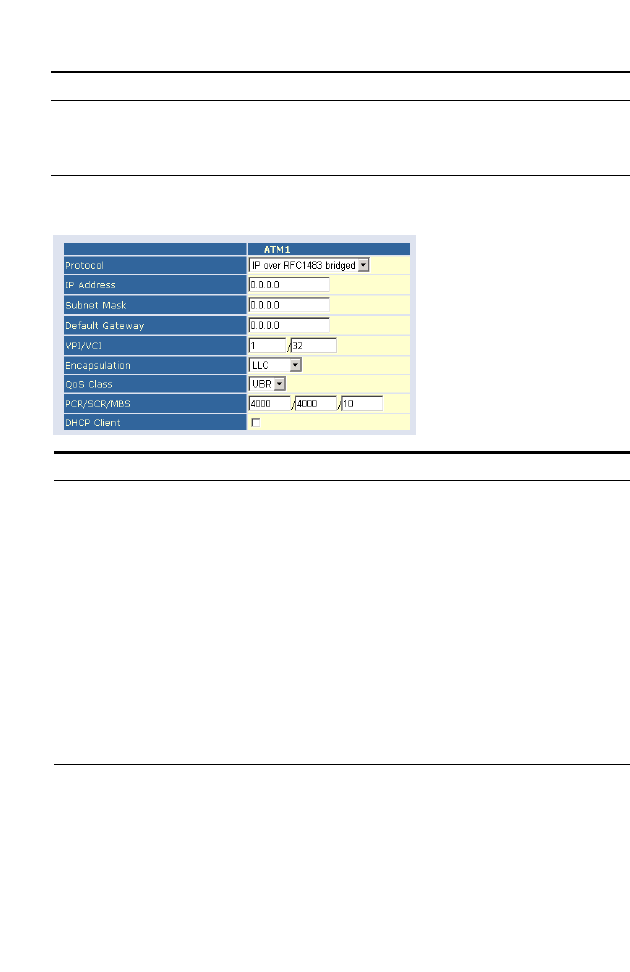
C
ONFIGURING
THE
B
ARRICADE
4-28
IP Over RFC1483 bridged
Confirm Password Confirm password
MTU Leave the Maximum Transmission Unit (MTU) at the
default value unless instructed by your ISP.
Parameter Description
IP Address Enter the IP address provided by your ISP.
Subnet Mask Enter the subnet mask address provided by your ISP.
Default Gateway Enter the gateway address provided by your ISP.
VPI/VCI Enter the Virtual Path Identifier (VPI) and Virtual
Circuit Identifier (VCI) supplied by your ISP.
Encapsulation Select the encapsulation used by ISP from the
drop-down menu.
QoS Class ATM QoS classes including CBR, UBR and VBR
PCR/SCR/MBS QoS Parameters - PCR, SCR and MBS are configurable.
DHCP Client Check the box if your ISP assigns an IP address
dynamically.
Parameter Description
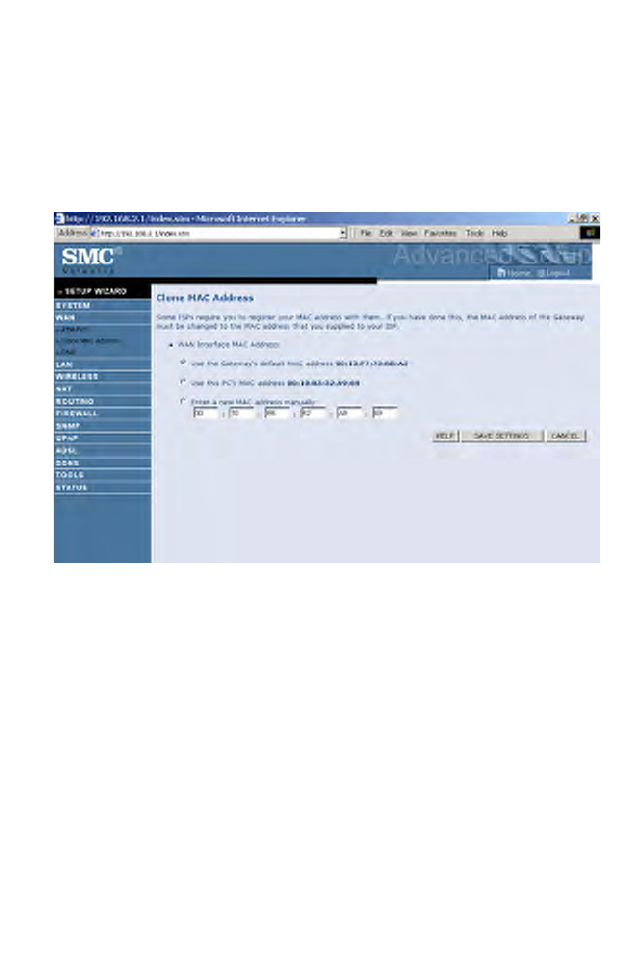
C
ONFIGURATION
PARAMETERS
4-29
Clone MAC Address
Some ISPs require you to register your MAC address with them. If this is
the case, and you have previously registered the MAC address of another
device, the MAC address of the Barricade must be changed to the MAC
address that you have registered with your ISP.

C
ONFIGURING
THE
B
ARRICADE
4-30
DNS
A Domain Name Server (DNS) is an index of IP addresses and Web
addresses. If you type a Web address into your browser, such as
www.smc.com, a DNS server will find that name in its index and find the
matching IP address: xxx.xxx.xxx.xxx. Most ISPs provide a DNS server
for speed and convenience. Since your Service Provider may connect to
the Internet with dynamic IP settings, it is likely that the DNS server IP's
are also provided dynamically. However, if there is a DNS server that you
would rather use, you need to specify the IP address here.
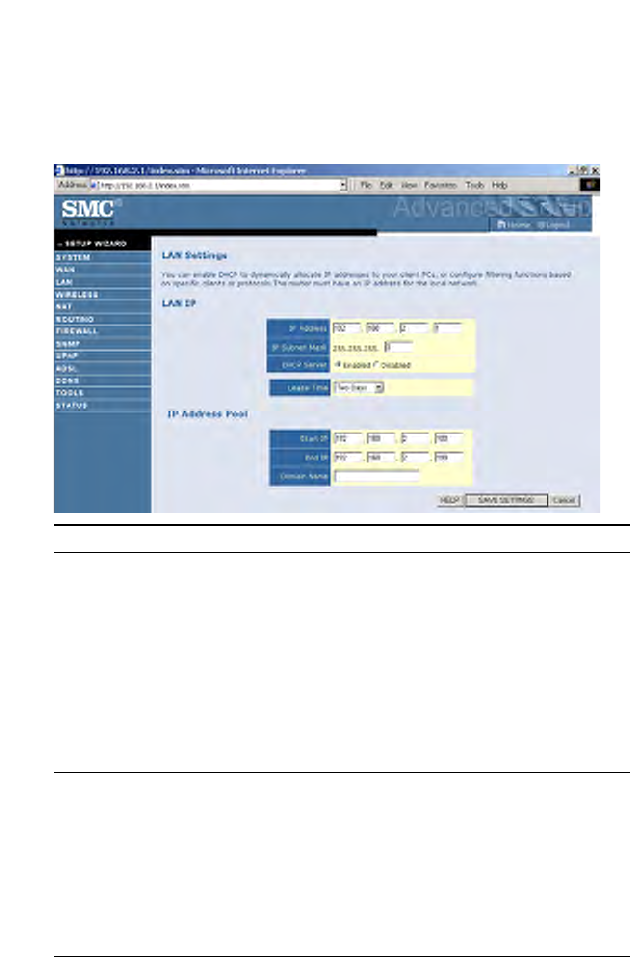
C
ONFIGURATION
PARAMETERS
4-31
LAN
The LAN settings menu allows you to change the default IP address of the
Barricade, modify the DHCP server settings.
Parameter Description
LAN IP
IP Address The IP address of the Barricade.
IP Subnet Mask The subnet mask of the Barricade.
DHCP Server This option allows you to enable or disable the DHCP
server function. By default DHCP is enabled.
Lease Time Allows you to select a pre-defined lease time for IP
addresses assigned using DHCP. For home networks this
may be set to Forever, which means there is no time limit
on the IP address lease.
IP Address Pool
Start IP Address/
End IP address Specify the start/end IP address of the DHCP pool. Do
not include the gateway address of the Barricade in the
client address pool. If you change the pool range, make
sure the first three octets match the gateway’s IP address,
i.e., 192.168.2.xxx.
Domain Name If your network uses a domain name, enter it here.
Otherwise, leave this field blank.
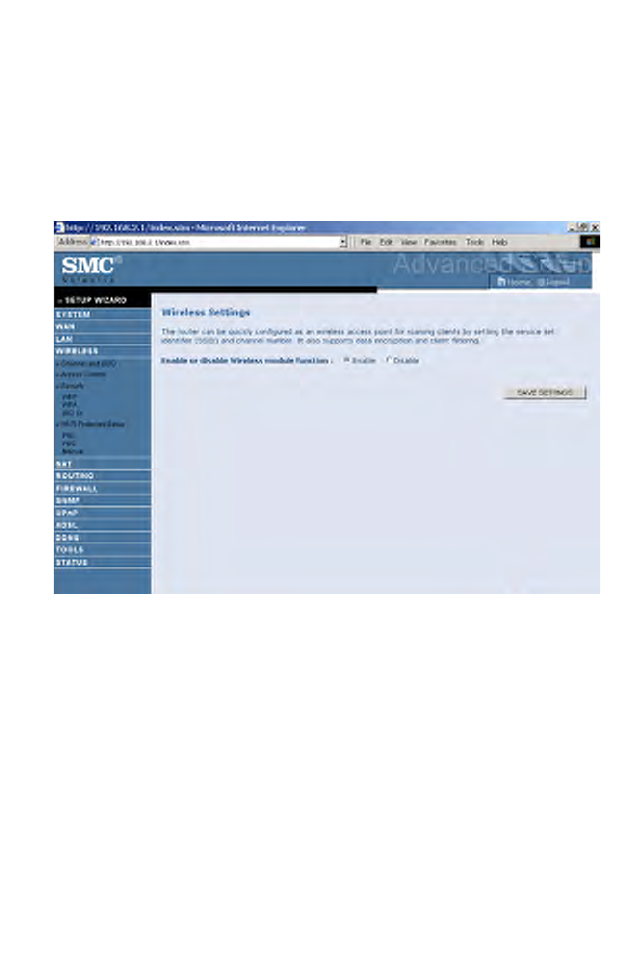
C
ONFIGURING
THE
B
ARRICADE
4-32
Wireless
The router also operates as a wireless access point, allowing wireless
computers to communicate with each other. To configure this function, all
you need to do is enable the wireless function, define the radio channel,
the domain identifier, and the security options.
• Enable or disable Wireless module function: select to enable or disable
the wireless function.
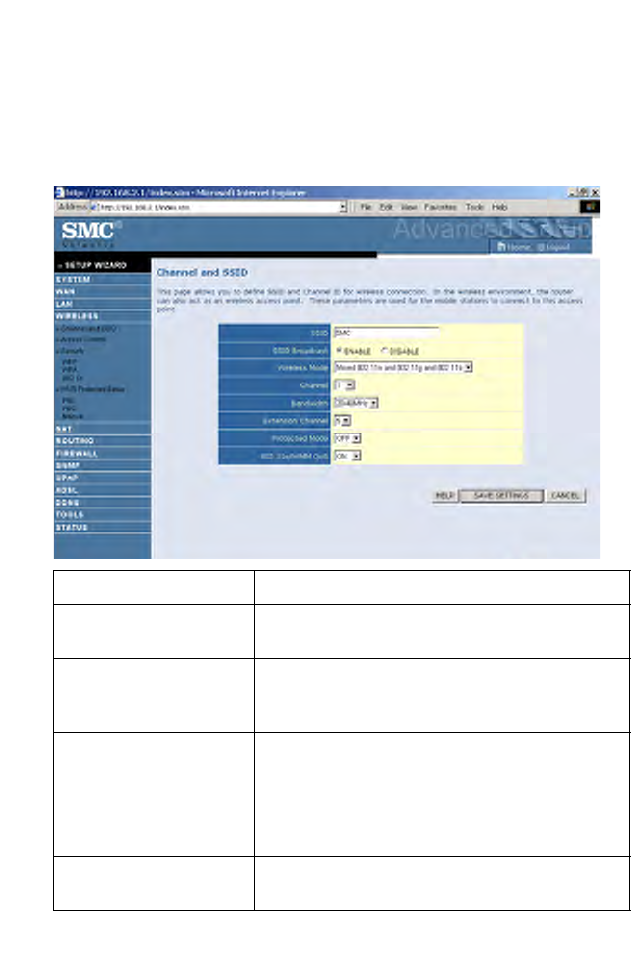
C
ONFIGURATION
PARAMETERS
4-33
Channel and SSID
You must specify a common radio channel and SSID (Service Set ID) to
be used by the router and all of its wireless clients. Be sure you configure
all of its clients to the same values.
Parameter Description
SSID This is the Service Set ID. The SSID must be the
same on the router and all of its wireless clients.
SSID Broadcast Select to enable/disable the brocasting of SSID.
Enable this function for easy connection for the
clients. Disable this function for increased security.
Wireless Mode The Router supports 11n, 11g, and 11b wireless
networks.
SMC recommend using “Mixed 802.11n, 802.11g
and 802.11b” to provide compatibility with 11n,
11g and 11b wireless clients.
Channel This is the radio channel used for wireless
communication.

C
ONFIGURING
THE
B
ARRICADE
4-34
Notes: 1. When bandwidth is set to 20 MHz, there would be no extension
channel that can be selected. The extension channel is based on the
main or primary channel. When the main channel is set to channel 1,
channel 5 will be used as the extension channel. When the main
channel is set to 9, the extension channel can be channel 5 or 13.
2. The availability of some specific channels and/or operational
frequency bands are country dependent and are firmware
programmed at the factory to match the intended destination. The
firmware setting is not accessible by the end user.
Bandwidth Select the bandwidth:
•20 MHz: Sets the operation bandwidth as 20
MHz. when 20 MHz is selected, there would be
no extension channel available.
•20/40 MHz: Allows automatic detection of the
operation bandwidth between 20 and 40 MHz.
Choosing this mode allows you to use the
extension channel.
Extension Channel This is the optional channel for use. Setting the
Bandwith to 20/40 MHz allows you to use this
extension channel as the secondary channel for
doubling the bandwith of your wireless network.
Protected Mode In most situations, best performance is achieved
with Protected Mode turning Off. If you are
operating in an environment with heavy 802.11b
traffic or interference, best performance may be
achieved with Protected Mode turning On.
802.11e/WMM QoS Select to turn on/turn off the QoS function.
Parameter Description

C
ONFIGURATION
PARAMETERS
4-35
Access Control
Using the Access Control functionality, you can restrict access based on
MAC address. Each PC has a unique identifier known as a Medium Access
Control (MAC) address. With MAC filtering enabled, the computers
whose MAC address you have listed in the filtering table will be able to
connect (or will be denied access) to the router.
• Enable MAC Filtering: select to enable or disable this function.
• Access Rule for registered MAC address: select to allow/deny access
for the registered MAC addresses. Selecting Allow means only MAC
addresses registered here will be able to connect to the router.
Selecting Deny means only the MAC addresses registered here will be
denied access to the router.
• Wireless DHCP Client List: use the drop down list to quickly copy the
current entry to the table.
• MAC Filtering Table: you can enter up to 32 stations to the table.
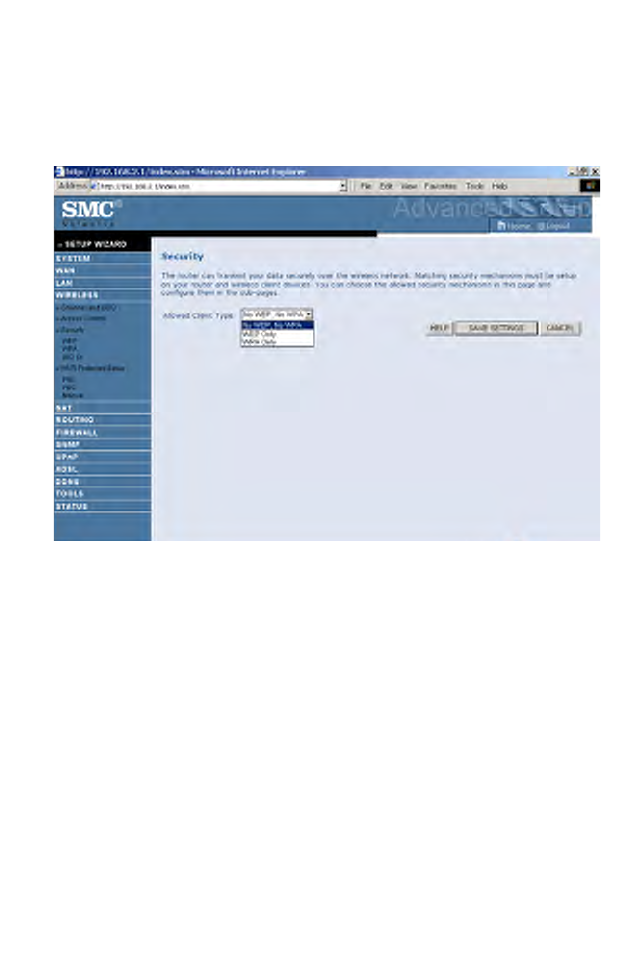
C
ONFIGURING
THE
B
ARRICADE
4-36
Security
To make your wireless network safe, you should turn on the security
function.
Allowed Client Type:
• No WEP, No WPA - this means no security mechanism will be used
on your wireless network.
• WEP only - this menas only WEP will be used for your wireless
communication.
• WPA only - this means only WPA will be used for the wireless
network.
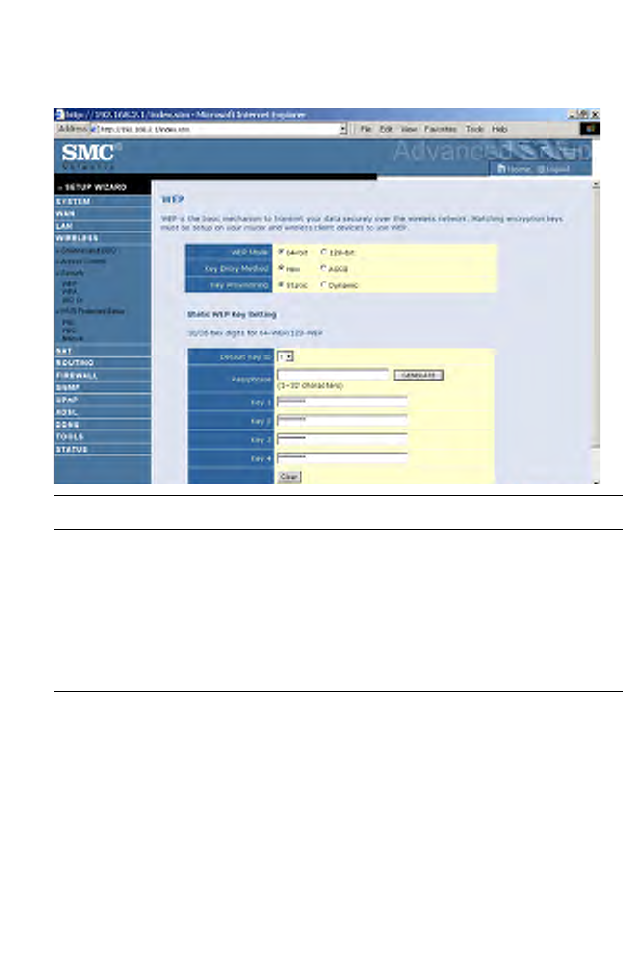
C
ONFIGURATION
PARAMETERS
4-37
WEP
To automatically generate encryption keys using the passphrase function,
when Key Entry Method is set to Hex, enter a string into the passphrase
field, then click Generate. Select the Default Key ID from the
drop-down menu and click SAVE SETTINGS.
To manually configure the encryption key, enter five hexadecimal pairs of
digits for each 64-bit key, or enter 13 pairs for the single 128-bit key.
Note: A hexadecimal digit is a number or letter in the range 0-9 or A-F.
The passphrase can consist of up to 32 alphanumeric characters.
Parameter Description
WEP Mode Select 64 bit, or 128 bit.
Key Entry Method Select Hex, or ASCII.
Key Provisioning Select Static, or Dynamic. If you select Static, you
will need to configure the Static WEP Key Setting
section. If you choose Dynamic, then 802.1X
authentication should be enabled.
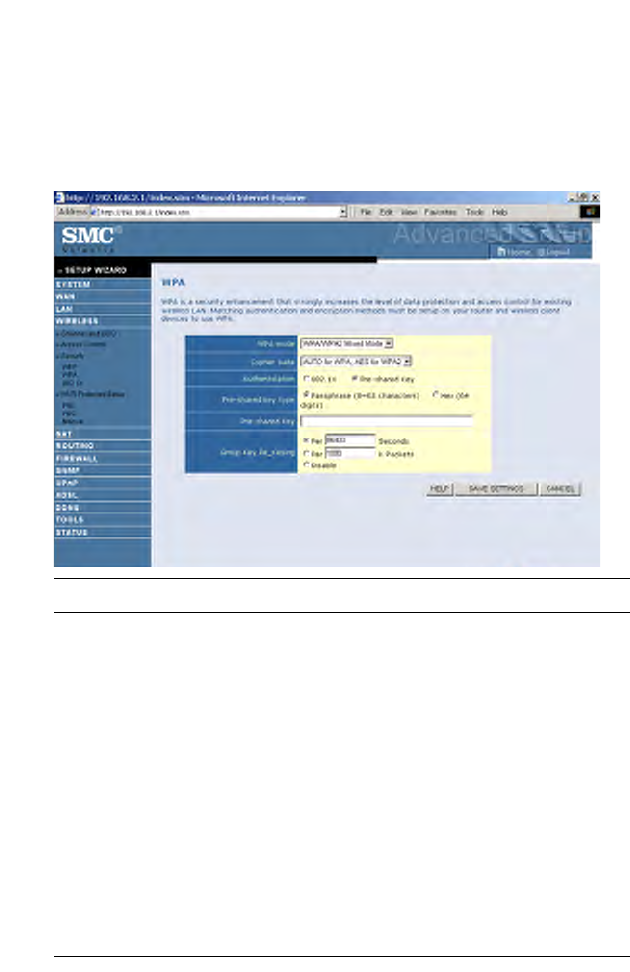
C
ONFIGURING
THE
B
ARRICADE
4-38
WPA
Wi-Fi Protected Access (WPA) combines temporal key integrity protocol
(TKIP) and 802.1X mechanisms. It provides dynamic key encryption and
802.1X authentication service. The router supports both WPA and WPA2.
Parameter Description
WPA mode Select WPA, WPA2 or mixed mode.
Cypher suite Select the encryption cypher for use.
Authentication Choose 802.1X or Pre-shared Key to use as the
authentication method.
•802.1X: for the enterprise network with a
RADIUS server.
•Pre-shared key: for the SOHO network
environment without an authentication server.
Pre-shared key type Select the key type to be used in the Pre-shared
Key.
Pre-shared Key Enter the key string here.
Group Key Re_Keying Define the time period for re-obtain the key.

C
ONFIGURATION
PARAMETERS
4-39
802.1X
If 802.1X is used in your network, then you should enable this function for
the router.
Parameter Description
802.1X authentication Choose to enable or disable this function.
Session Idle Timeout Defines a maximum period of time for which the
connection is maintained during inactivity.
Re-Authentication
Period
Defines a maximum period of time for which the
authentication server will dynamically re-assign a
session key to a connected client.
Quiet Period Defines a maximum period of time for which the
router will wait between failed authentications.
Server Type Select RADIUS.
RADIUS Server Parameters
Server IP Enter the authentication server IP address.
Server Port Enter the port number.
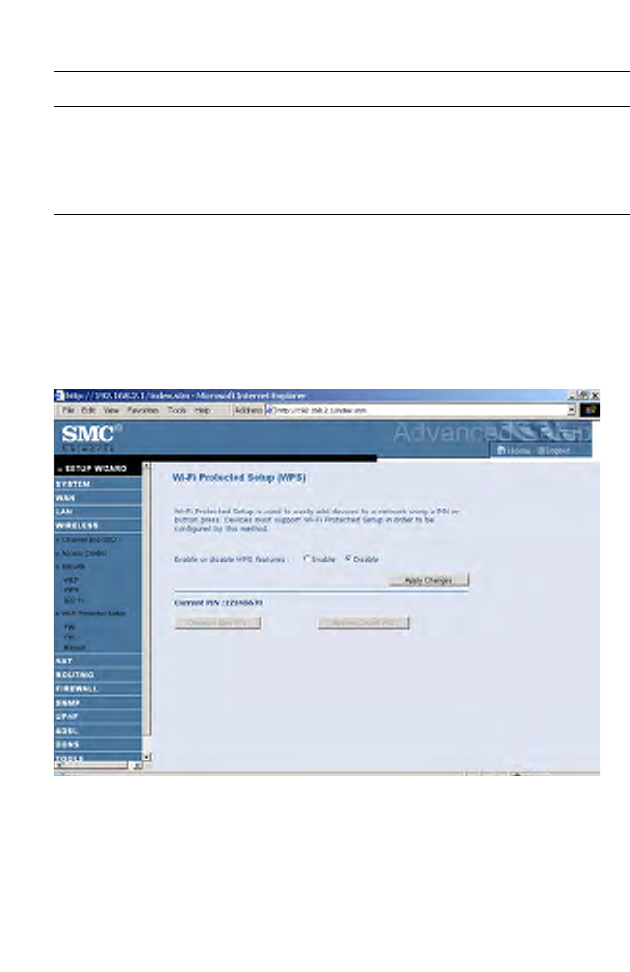
C
ONFIGURING
THE
B
ARRICADE
4-40
WPS (Wi-Fi Protected Setup)
The Barricade was implemented with the ease-of-use Wi-Fi Protected
Setup (WPS). WPS makes a secure wireless network much easier to achieve
by using a PIN number and the Push Button Control (PBC).
• Enable or disable WPS features: select to enable or disable.
• Generate New PIN: click this button to create a new PIN.
• Restore Default PIN: click this button to restore the PIN.
Secret Key The secret key shared between the authentication
server and its clients.
NAS-ID Defines the request identifier of the Network
Access Server.
Parameter Description

C
ONFIGURATION
PARAMETERS
4-41
PIN
Enter the PIN of the client device and click Start PIN. Then start WPS on
the client device from it's wireless utility or WPS application within 2
minutes.
Take the following steps for easy network security settings.
1. Power on your client device supporting WPS PIN code method.
2. Start WPS PIN process on client device. For instructions on how to do
this refer to the client devices user manual.
3. Enter the PIN code of client device. Note: The PIN code is generally
printed on the bottom of the unit or displayed in the utility.
4. Click the Start PIN button on the screen.

C
ONFIGURING
THE
B
ARRICADE
4-42
PBC (Push Button Configuration)
To achieve successful WPS connection, you can use one of the following
ways:
(1) push and hold the WPS button on this router for 4 seconds
or
(2) click the Start PBC button on this screen.
Now click the WPS button on the client device which you are connecting.
Make sure the client device is powered on.
Note: This connection procedure must be done within 2 minutes after
pressing the WPS button on the router.
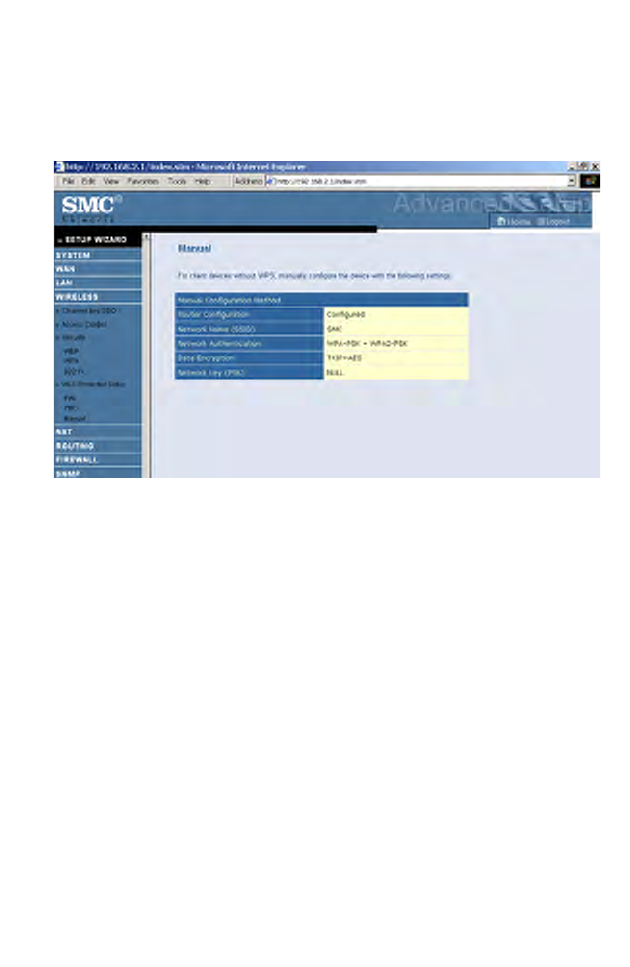
C
ONFIGURATION
PARAMETERS
4-43
Manual
For client devices without the WPS function, you should manually
configure the client device with the settings on this screen.
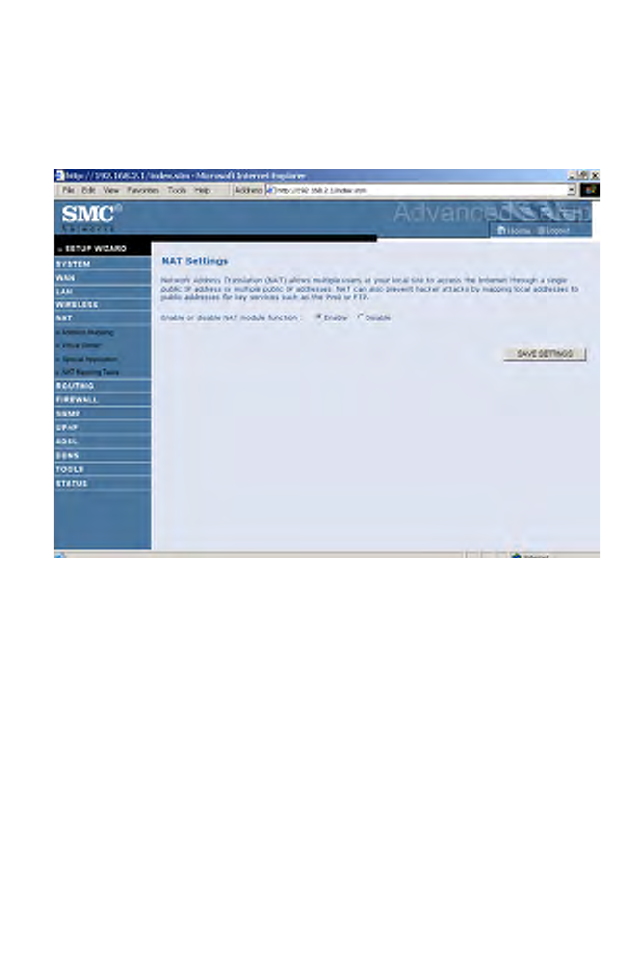
C
ONFIGURING
THE
B
ARRICADE
4-44
NAT
Network Address Translation (NAT) allows multiple users to access the
Internet sharing one public IP.
• Enable or disable NAT module function: select to enable or disable
this function.

C
ONFIGURATION
PARAMETERS
4-45
Address Mapping
Allows one or more public IP addresses to be shared by multiple internal
users. This also hides the internal network for increased privacy and
security.
• Enter the Public IP address you wish to share into the Global IP field.
• Enter a range of internal IPs that will share the global IP into the
“from” field.

C
ONFIGURING
THE
B
ARRICADE
4-46
Virtual Server
If you configure the Barricade as a virtual server, remote users accessing
services such as web or FTP at your local site via public IP addresses can
be automatically redirected to local servers configured with private IP
addresses. In other words, depending on the requested service (TCP/UDP
port number), the Barricade redirects the external service request to the
appropriate server (located at another internal IP address).
For example, if you set Type/Public Port to TCP/80 (HTTP or web) and
the Private IP/Port to 192.168.2.2/80, then all HTTP requests from
outside users will be transferred to 192.168.2.2 on port 80. Therefore, by
just entering the IP address provided by the ISP, Internet users can access
the service they need at the local address to which you redirect them.
The more common TCP service ports include:
HTTP: 80, FTP: 21, Telnet: 23, and POP3: 110.
A list of ports is maintained at the following link:
http://www.iana.org/assignments/port-numbers.
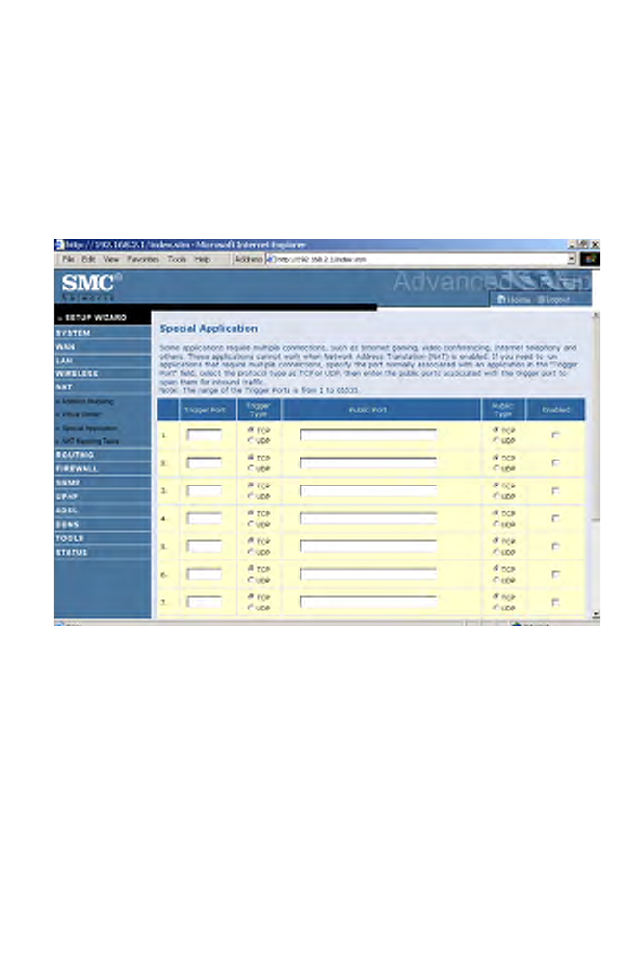
C
ONFIGURATION
PARAMETERS
4-47
Special Application
Some applications require multiple connections, such as Internet gaming,
video-conferencing, and Internet telephony. These applications may not
work when Network Address Translation (NAT) is enabled. If you need to
run applications that require multiple connections, use these screens to
specify the additional public ports to be opened for each application.
• Use the Popular applications drop down menu to quickly copy the
entry to the table.
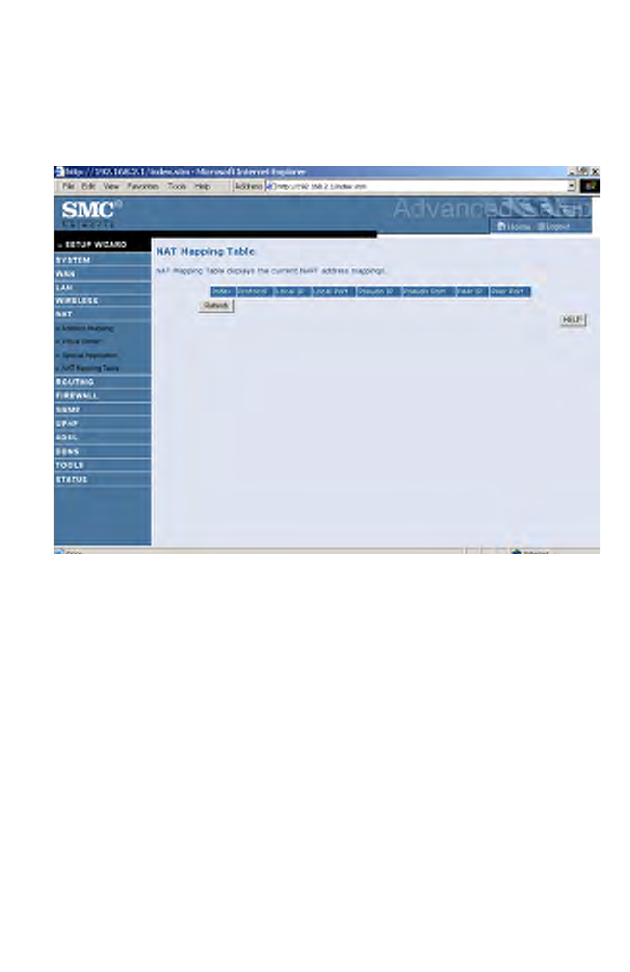
C
ONFIGURING
THE
B
ARRICADE
4-48
NAT Mapping Table
This screen displays the current NAPT (Network Address Port
Translation) address mappings. Click Refresh to update the table.

C
ONFIGURATION
PARAMETERS
4-49
Routing
These screens define routing related parameters, including static routes and
RIP (Routing Information Protocol) parameters.
Static Route
Click Add to add a new static route to the list, or check the box of an
already entered route and click Modify. Clicking Delete will remove an
entry from the list.
Parameter Description
Index Check the box of the route you wish to delete or modify.
Network Address Enter the IP address of the remote computer for which
to set a static route.
Subnet Mask Enter the subnet mask of the remote network for which
to set a static route.
Gateway Enter the WAN IP address of the gateway to the remote
network.
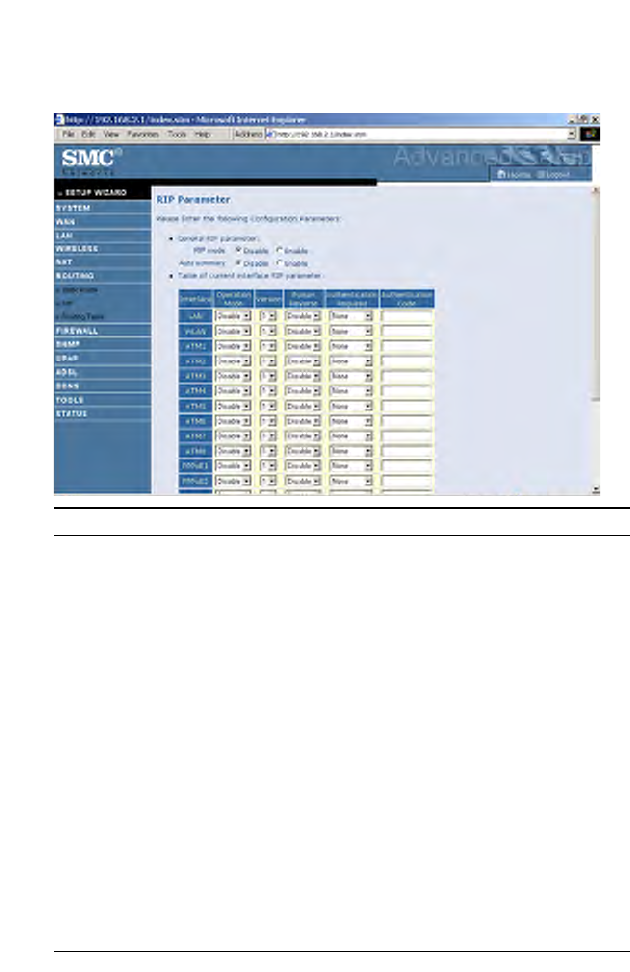
C
ONFIGURING
THE
B
ARRICADE
4-50
RIP
Parameter Description
General RIP Parameters
RIP mode Globally enables or disables RIP.
Auto summary If Auto summary is disabled, then RIP packets will
include sub-network information from all
sub-networks connected to the router. If enabled,
this sub-network information will be summarized
to one piece of information covering all
sub-networks.
Table of current Interface RIP parameter
Interface The WAN interface to be configured.
Operation Mode Disable: RIP disabled on this interface.
Enable: RIP enabled on this interface.
Silent: Listens for route broadcasts and updates its
route table. It does not participate in sending route
broadcasts.
Version Sets the RIP (Routing Information Protocol)
version to use on this interface.

C
ONFIGURATION
PARAMETERS
4-51
RIP sends routing-update messages at regular intervals and when the
network topology changes. When a router receives a routing update that
includes changes to an entry, it updates its routing table to reflect the new
route. RIP routers maintain only the best route to a destination. After
updating its routing table, the router immediately begins transmitting
routing updates to inform other network routers of the change.
Poison Reverse A method for preventing loops that would cause
endless retransmission of data traffic.
Authentication Required • None: No authentication.
• Password: A password authentication key is
included in the packet. If this does not match
what is expected, the packet will be discarded.
This method provides very little security as it
is possible to learn the authentication key by
watching RIP packets.
• MD5: An algorithm that is used to verify data
integrity through the creation of a 128-bit
message digest from data input (which may
be a message of any length) that is claimed to
be as unique to that specific data as a
fingerprint is to a specific individual.
Authentication Code Password or MD5 Authentication key.
Parameter Description
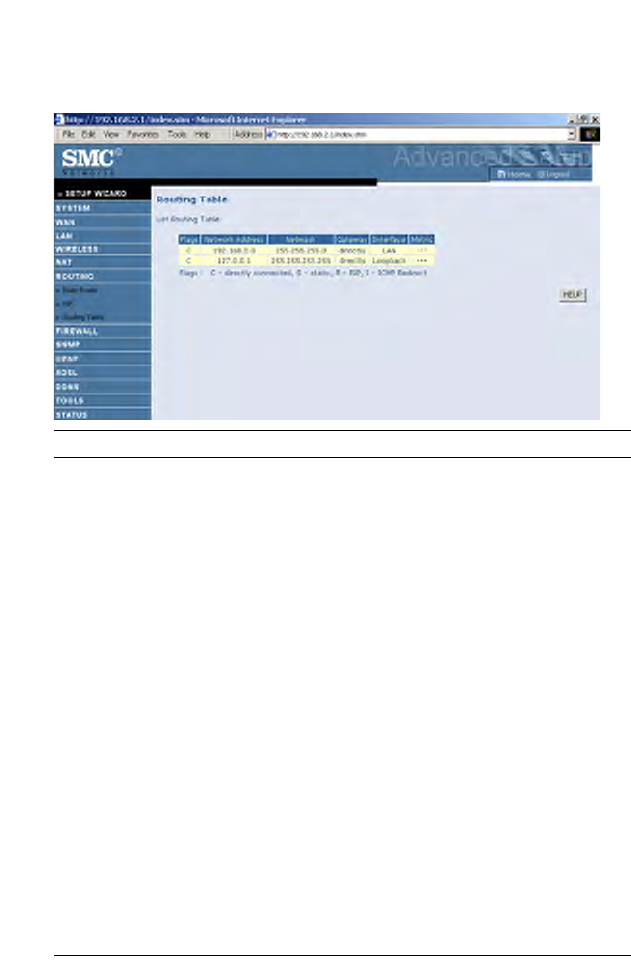
C
ONFIGURING
THE
B
ARRICADE
4-52
Routing Table
Parameter Description
Flags Indicates the route status:
C = Direct connection on the same subnet.
S = Static route.
R = RIP (Routing Information Protocol) assigned route.
I = ICMP (Internet Control Message Protocol) Redirect route.
Network
Address
Destination IP address.
Netmask The subnetwork associated with the destination.
This is a template that identifies the address bits in the destination
address used for routing to specific subnets. Each bit that
corresponds to a “1” is part of the subnet mask number; each bit
that corresponds to “0” is part of the host number.
Gateway The IP address of the router at the next hop to which frames are
forwarded.
Interface The local interface through which the next hop of this route is
reached.
Metric When a router receives a routing update that contains a new or
changed destination network entry, the router adds 1 to the metric
value indicated in the update and enters the network in the routing
table.
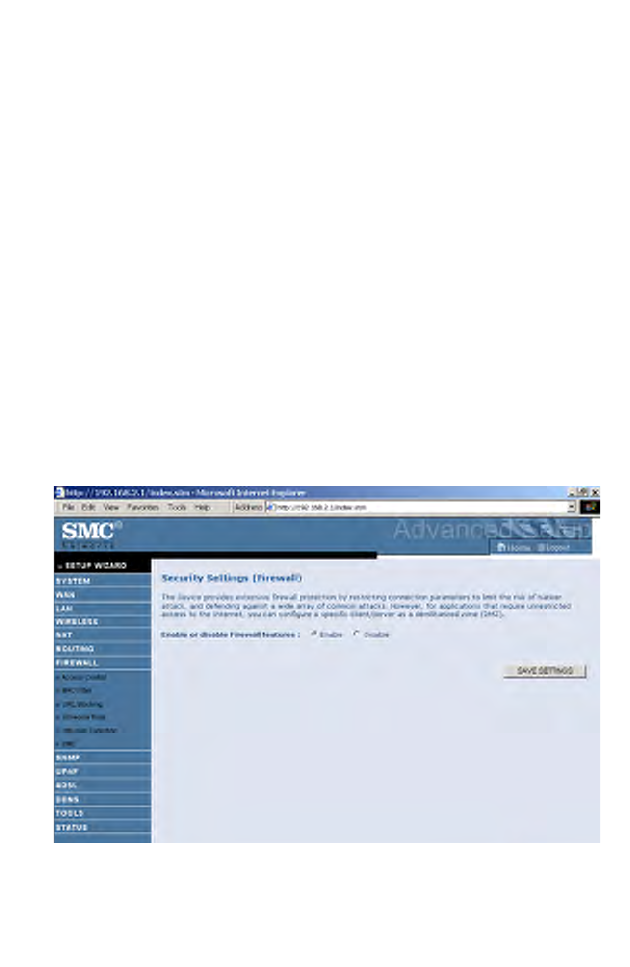
C
ONFIGURATION
PARAMETERS
4-53
Firewall
The Barricade Router’s firewall inspects packets at the application layer,
maintains TCP and UDP session information including time-outs and the
number of active sessions, and provides the ability to detect and prevent
certain types of network attacks.
Network attacks that deny access to a network device are called
Denial-of-Service (DoS) attacks. DoS attacks are aimed at devices and
networks with a connection to the Internet. Their goal is not to steal
information, but to disable a device or network so users no longer have
access to network resources.
The Barricade protects against the following DoS attacks: IP Spoofing,
Land Attack, Ping of Death, IP with zero length, Smurf Attack, UDP port
loopback, Snork Attack, TCP null scan, and TCP SYN flooding.
(For details see page 4-60.)
The firewall does not significantly affect system performance, so we advise
enabling the function to protect your network.
Select Enable and click the SAVE SETTINGS button.
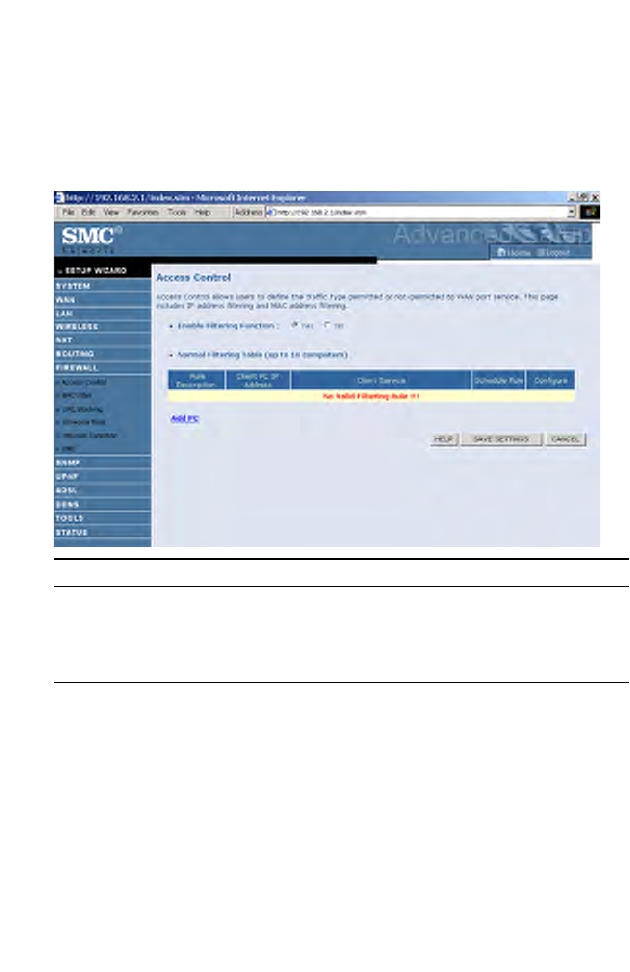
C
ONFIGURING
THE
B
ARRICADE
4-54
Access Control
Access Control allows users to define the outgoing traffic permitted or
not-permitted through the WAN interface. The default is to permit all
outgoing traffic.
Parameter Description
Enable Filtering
Function
Enable or Disable Access control function.
Normal Filtering
Table
Displays descriptive list of filtering rules defined.

C
ONFIGURATION
PARAMETERS
4-55
To create a new access control rule:
1. Click Add PC on the Access Control screen. The Access Control Add
PC screen will appear.
2. Define the appropriate rule settings for client PC services.
3. Click OK and then click SAVE SETTINGS to save your settings.

C
ONFIGURING
THE
B
ARRICADE
4-56
MAC Filter
The MAC Filter allows you to define what client PC's can access the
Internet. When filtering function is enabled only the MAC addresses
defined in the MAC Filtering table will have access to the Internet. All
other client devices will be denied access.
You can enter up to 32 MAC addresses in this table.
• MAC Address Control: select enable or disable.
• MAC Filtering Table: enter the MAC address in the space provided.
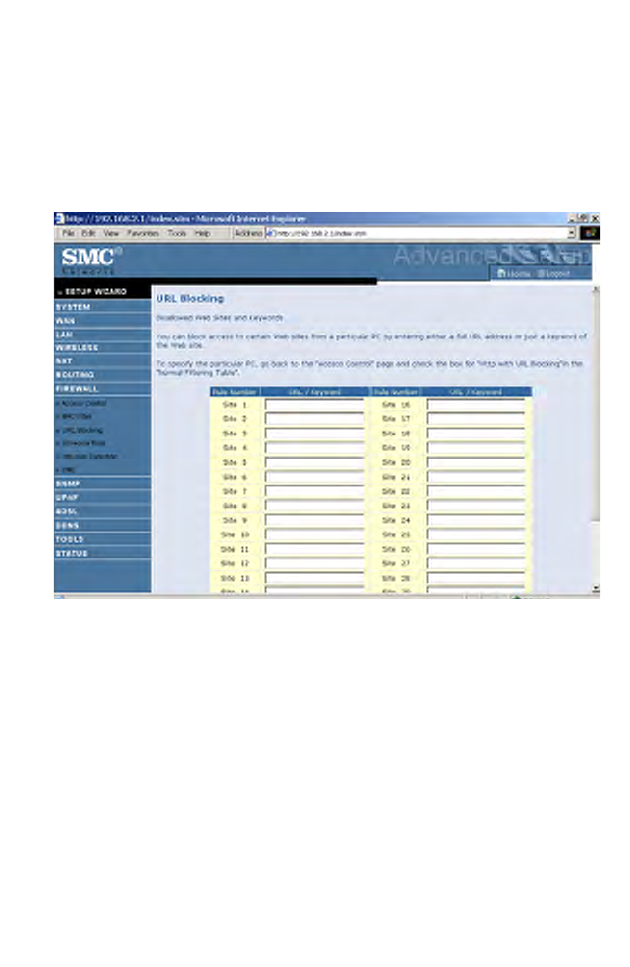
C
ONFIGURATION
PARAMETERS
4-57
URL Blocking
The Barricade allows the user to block access to web sites by entering
either a full URL address or just a keyword. This feature can be used to
protect children from accessing violent or pornographic web sites. You can
define up to 30 sites here.
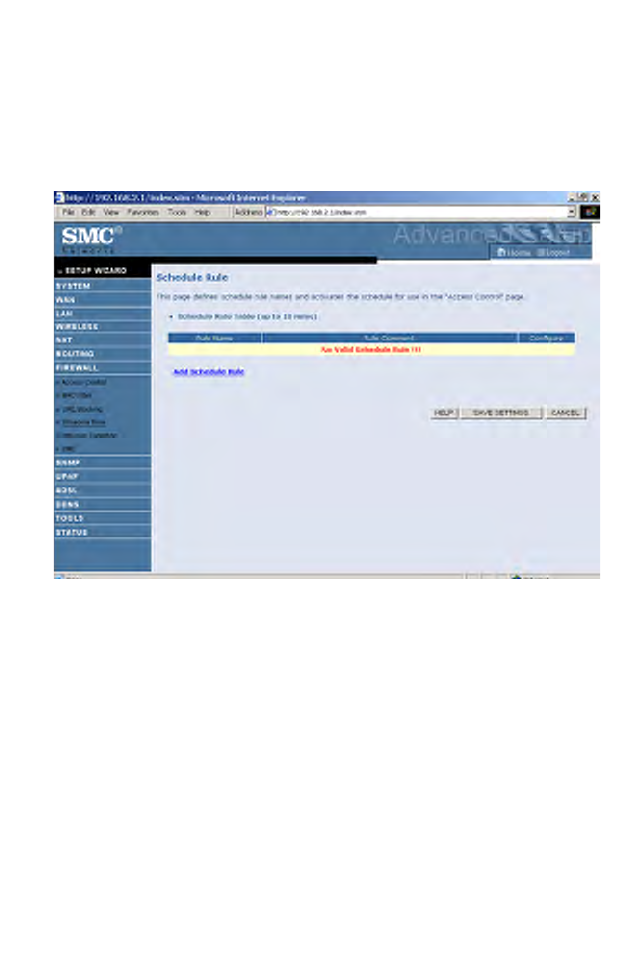
C
ONFIGURING
THE
B
ARRICADE
4-58
Schedule Rule
You may filter Internet access for local clients based on rules. Each access
control rule may be activated at a scheduled time. Define the schedule on
the Schedule Rule screen, and apply the rule on the Access Control screen.
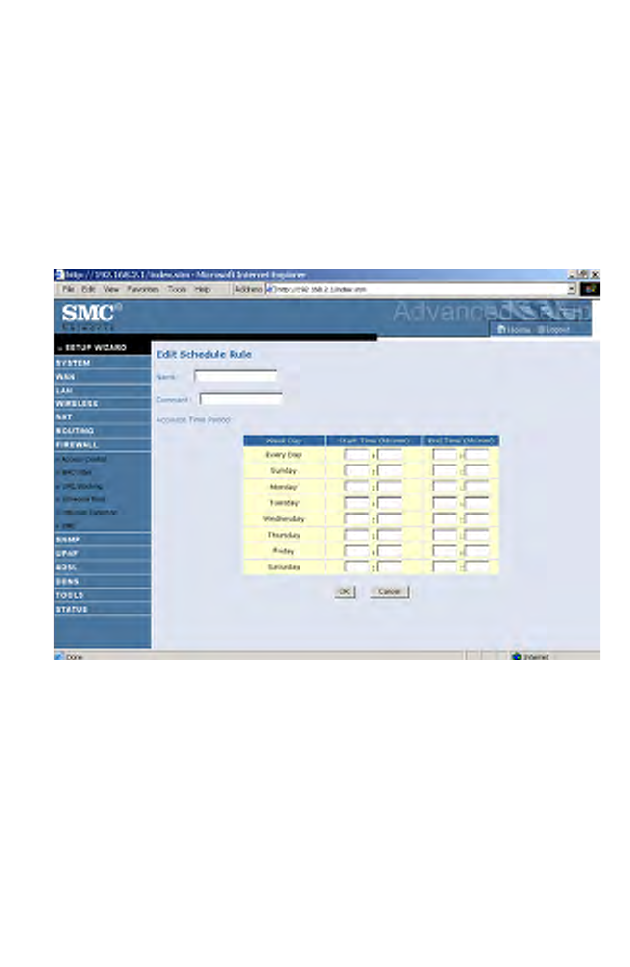
C
ONFIGURATION
PARAMETERS
4-59
Follow these steps to add a schedule rule:
1. Click Add Schedule Rule on the Schedule Rule screen. The Edit
Schedule Rule screen will appear.
2. Define the appropriate settings for a schedule rule.
3. Click OK and then click SAVE SETTINGS to save your settings.

C
ONFIGURING
THE
B
ARRICADE
4-60
Intrusion Detection
• Intrusion Detection Feature
Stateful Packet Inspection (SPI) and Anti-DoS firewall protection (Default:
Enabled) — The Intrusion Detection Feature of the Barricade Router
limits access for incoming traffic at the WAN port. When the SPI feature is
turned on, all incoming packets will be blocked except for those types
marked in the Stateful Packet Inspection section.
RIP Defect (Default: Enabled) — If an RIP request packet is not
acknowledged to by the router, it will stay in the input queue and not be
released. Accumulated packets could cause the input queue to fill, causing
severe problems for all protocols. Enabling this feature prevents the
packets from accumulating.
Discard Ping to WAN (Default: Disabled) — Prevent a ping on the
Barricade’s WAN port from being routed to the network.
Scroll down to view more information.
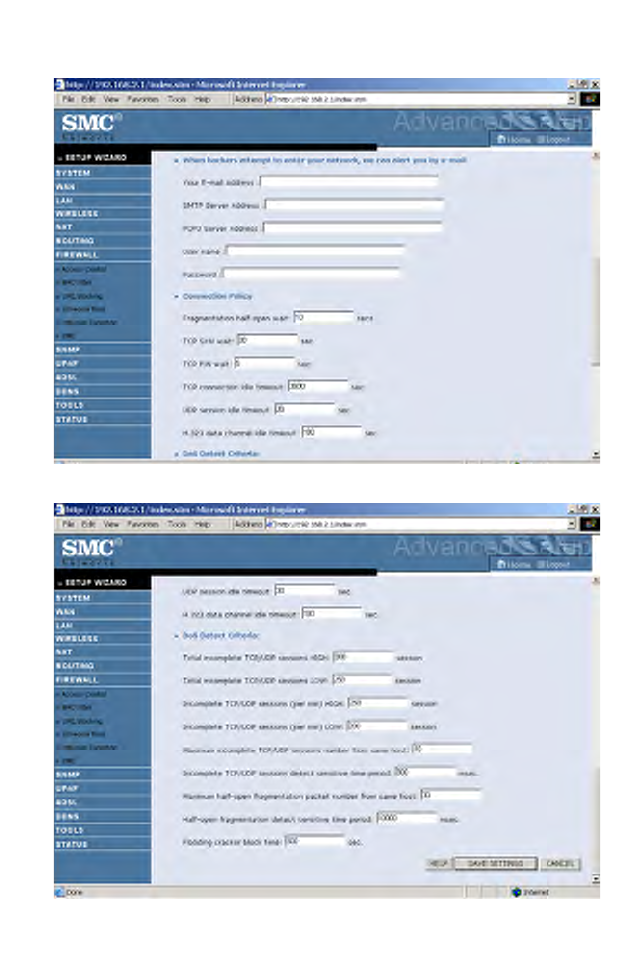
C
ONFIGURATION
PARAMETERS
4-61

C
ONFIGURING
THE
B
ARRICADE
4-62
•Stateful Packet Inspection
This is called a “stateful” packet inspection because it examines the
contents of the packet to determine the state of the communications; i.e., it
ensures that the stated destination computer has previously requested the
current communication. This is a way of ensuring that all communications
are initiated by the recipient computer and are taking place only with
sources that are known and trusted from previous interactions. In addition
to being more rigorous in their inspection of packets, stateful inspection
firewalls also close off ports until connection to the specific port is
requested.
When particular types of traffic are checked, only the particular type of
traffic initiated from the internal LAN will be allowed. For example, if the
user only checks “FTP Service” in the Stateful Packet Inspection section,
all incoming traffic will be blocked except for FTP connections initiated
from the local LAN.
Stateful Packet Inspection allows you to select different application types
that are using dynamic port numbers. If you wish to use the Stateful Packet
Inspection (SPI) to block packets, click on the Yes radio button in the
“Enable SPI and Anti-DoS firewall protection” field and then check the
inspection type that you need, such as Packet Fragmentation, TCP
Connection, UDP Session, FTP Service, H.323 Service, or TFTP Service.
•When hackers attempt to enter your network, we can
alert you by e-mail
Enter your email address. Specify your SMTP and POP3 servers, user
name, and password.

C
ONFIGURATION
PARAMETERS
4-63
•Connection Policy
Enter the appropriate values for TCP/UDP sessions as described in the
following table.
Parameter Defaults Description
Fragmentation
half-open wait
10 sec Configures the number of seconds that a
packet state structure remains active. When
the timeout value expires, the router drops
the unassembled packet, freeing that
structure for use by another packet.
TCP SYN
wait
30 sec Defines how long the software will wait for a
TCP session to synchronize before dropping
the session.
TCP FIN
wait
5 sec Specifies how long a TCP session will be
maintained after the firewall detects a FIN
packet.
TCP connection
idle timeout
3600
seconds
(1 hour)
The length of time for which a TCP session
will be managed if there is no activity.
UDP session idle
timeout
30 sec The length of time for which a UDP session
will be managed if there is no activity.
H.323 data
channel
idle timeout
180 sec The length of time for which an H.323
session will be managed if there is no activity.

C
ONFIGURING
THE
B
ARRICADE
4-64
•DoS Criteria and Port Scan Criteria
Set up DoS and port scan criteria in the spaces provided (as shown below).
Note: The firewall does not significantly affect system performance, so
we advise enabling the prevention features to protect your
network.
Parameter Defaults Description
Total incomplete
TCP/UDP sessions
HIGH
300
sessions
Defines the rate of new unestablished sessions
that will cause the software to start deleting
half-open sessions.
Total incomplete
TCP/UDP sessions
LOW
250
sessions Defines the rate of new unestablished sessions
that will cause the software to stop deleting half-
open sessions.
Incomplete
TCP/UDP sessions
(per min) HIGH
250
sessions Maximum number of allowed incomplete
TCP/UDP sessions per minute.
Incomplete
TCP/UDP sessions
(per min) LOW
200
sessions Minimum number of allowed incomplete
TCP/UDP sessions per minute.
Maximum incomplete
TCP/UDP sessions
number from same
host
10 Maximum number of incomplete TCP/UDP
sessions from the same host.
Incomplete
TCP/UDP sessions
detect sensitive time
period
300
msec Length of time before an incomplete
TCP/UDP session is detected as incomplete.
Maximum half-open
fragmentation packet
number from same
host
30 Maximum number of half-open fragmentation
packets from the same host.
Half-open
fragmentation detect
sensitive time period
10000
msec Length of time before a half-open
fragmentation session is detected as half-open.
Flooding cracker
block time
300
second Length of time from detecting a flood attack to
blocking the attack.
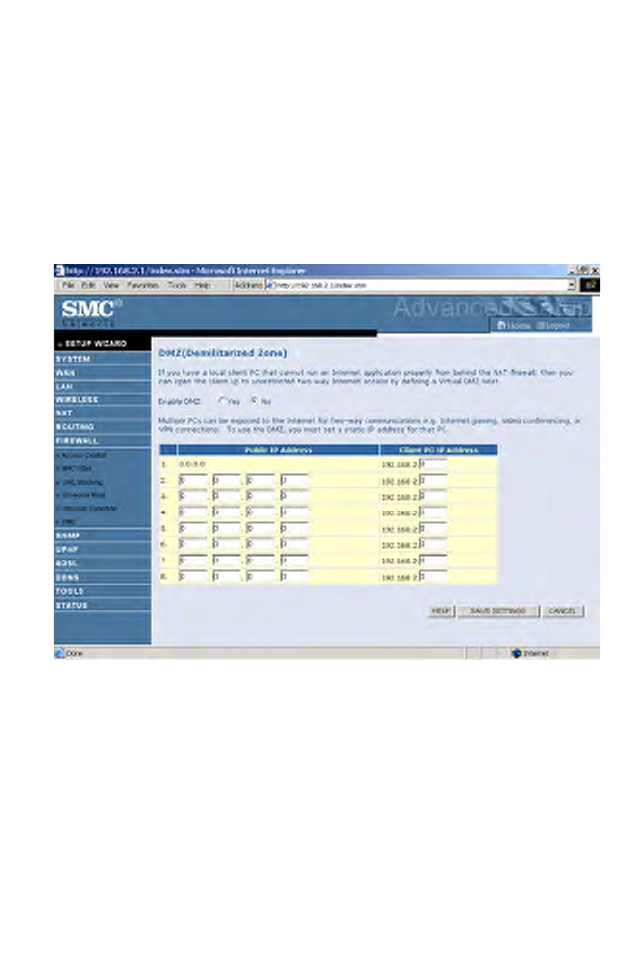
C
ONFIGURATION
PARAMETERS
4-65
DMZ
If you have a client PC that cannot run an Internet application properly
from behind the firewall, you can open the client up to unrestricted
two-way Internet access. Enter the IP address of a DMZ (Demilitarized
Zone) host on this screen. Adding a client to the DMZ may expose your
local network to a variety of security risks, so only use this option as a last
resort.
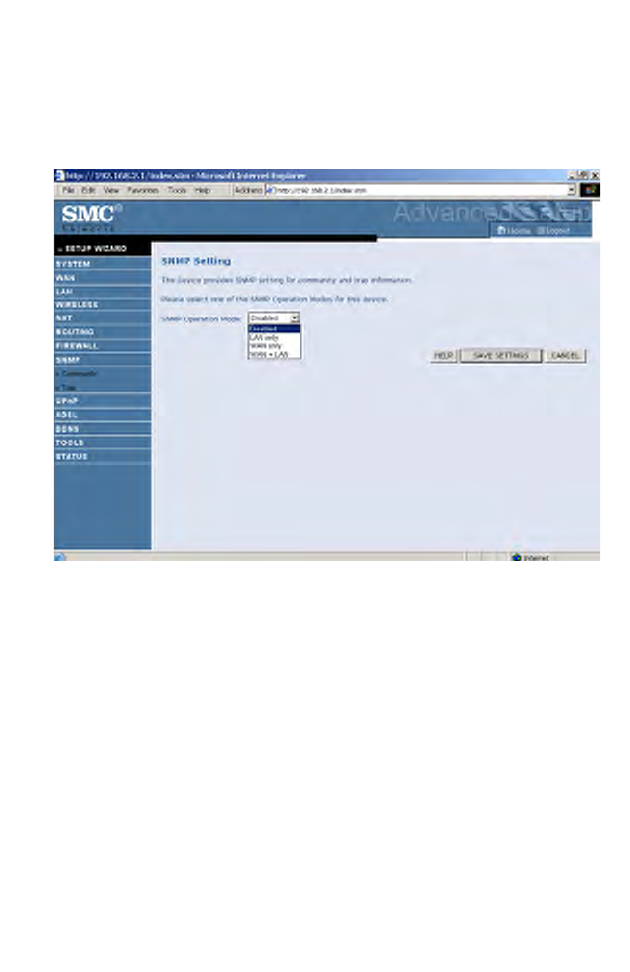
C
ONFIGURING
THE
B
ARRICADE
4-66
SNMP
Use the SNMP configuration screen to display and modify parameters for
the Simple Network Management Protocol (SNMP).
• Select the SNMP Operation mode from the drop down menu.

C
ONFIGURATION
PARAMETERS
4-67
Community
A computer attached to the network, called a Network Management
Station (NMS), can be used to access this information. Access rights to the
agent are controlled by community strings. To communicate with the
Barricade, the NMS must first submit a valid community string for
authentication.
Note: Up to five community names may be entered.
Parameter Description
Community A community name authorized for management access.
Access Management access is restricted to Read Only (Read) or
Read/Write (Write).
Valid Enables/disables the entry.

C
ONFIGURING
THE
B
ARRICADE
4-68
Trap
Specify the IP address of the NMS to notify when a significant event is
detected by the agent. When a trap condition occurs, the SNMP agent
sends an SNMP trap message to any NMS specified as a trap receiver.
Parameter Description
IP Address Traps are sent to this address when errors or specific events
occur on the network.
Community A community string (password) specified for trap
management. Enter a word, something other than public or
private, to prevent unauthorized individuals from accessing
information on your system.
Version Sets the trap status to disabled, or enabled with V1 or V2c.
The v2c protocol was proposed in late 1995 and includes
enhancements to v1 that are universally accepted. These
include a get-bulk command to reduce network management
traffic when retrieving a sequence of MIB variables, and a
more elaborate set of error codes for improved reporting to a
Network Management Station.

C
ONFIGURATION
PARAMETERS
4-69
UPnP
The Universal Plug and Play architecture offers pervasive peer-to-peer
network connectivity of PCs of all form factors, intelligent appliances, and
wireless devices.
UPnP enables seamless proximity network in addition to control and data
transfer among networked devices in the office, home and everywhere
within your network.
UPnP allows the device to automatically:
• join a network
• obtain an IP address
• convey its capabilities and learn about the presence and capabilities of
other devices.
Check Enable to activate this function.
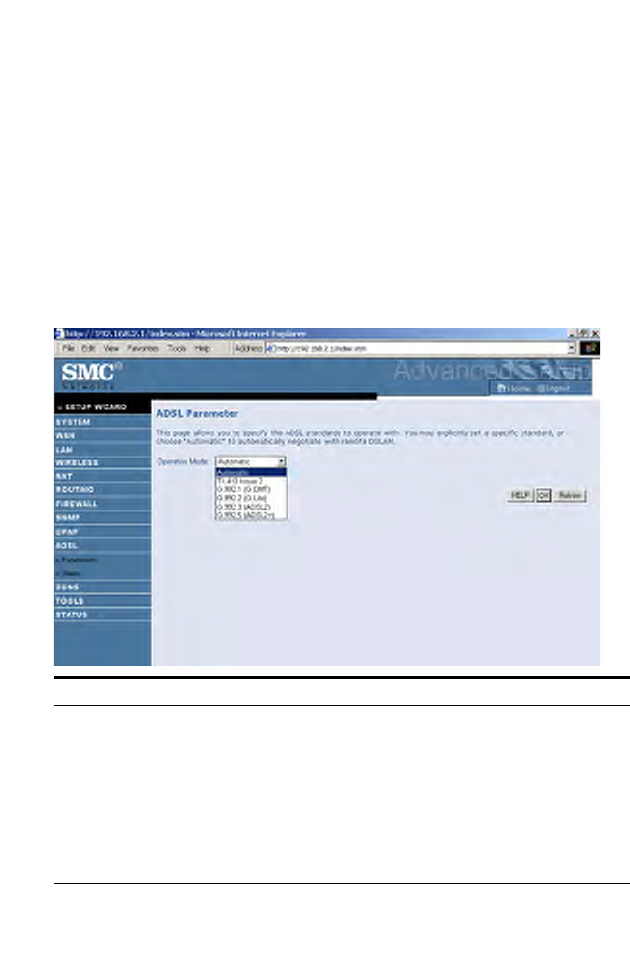
C
ONFIGURING
THE
B
ARRICADE
4-70
ADSL
ADSL (Asymmetric Digital Subscriber Line) is designed to deliver more
bandwidth downstream (from the central office to the customer site) than
upstream. This section is used to configure the ADSL operation type and
shows the ADSL status.
ADSL Parameters
This screen is designed for the engineer to test the ADSL loop condition.
Therefore, it is advised that users should not change the settings here at all.
Parameter Description
Operation Mode • Automatic
• T1.413 Issue 2
•G.992.1 (G.DMT)
•G.992.2 (G.Lite)
•G.992.3 ADSl2
•G.992.5 ADSL2+
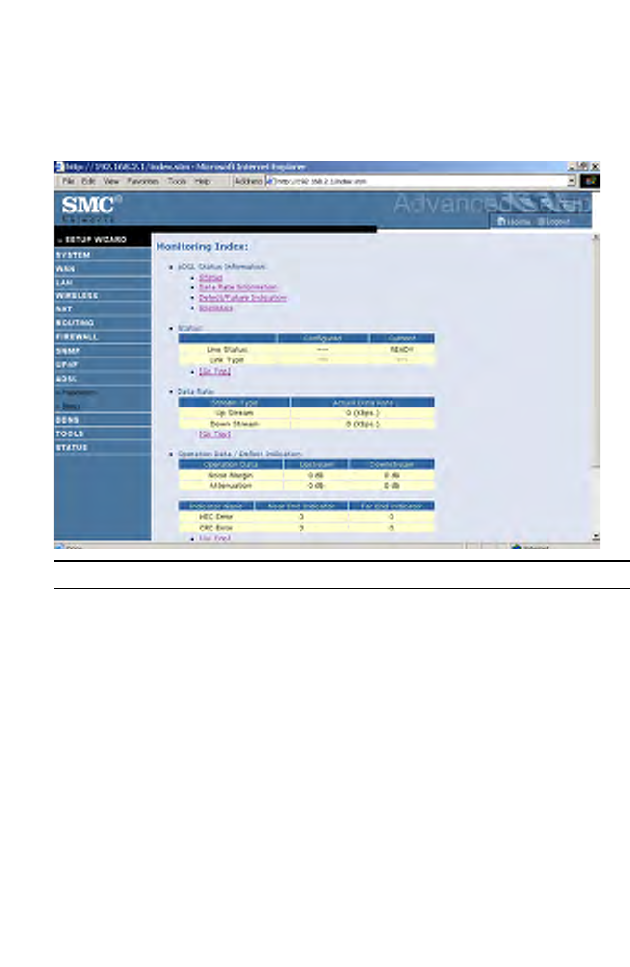
C
ONFIGURATION
PARAMETERS
4-71
ADSL Status
The Status screen displays information on connection line status, data rate,
operation data and defect indication, and statistics.
Parameter Description
Status
Line Status Shows the current status of the ADSL line
connection.
Data Rate
Upstream Maximum upstream data rate.
Downstream Maximum downstream data rate.
Operation Data/Defect Indication
Noise Margin Maximum upstream and downstream noise margin.
Output Power Maximum fluctuation in the output power.
Attenuation Maximum reduction in the strength of the
upstream and downstream signal.

C
ONFIGURING
THE
B
ARRICADE
4-72
Fast Path
FEC Correction There are two latency paths that may be used: fast
and interleaved. For either path, a forward error
correction (FEC) scheme is employed to ensure
higher data integrity. For maximum noise
immunity, an interleaver may be used to
supplement FEC.
Interleaved Path
FEC Correction An interleaver is basically a buffer used to introduce
a delay, allowing for additional error correction
techniques to handle noise. Interleaving slows the
data flow and may not be optimal for real-time
signals such as video transmission.
Fast Path CRC
Error The number of Fast Path Cyclic Redundancy Check
errors.
Interleaved Path
CRC Error The number of Interleaved Path Cyclic
Redundancy Check errors.
Loss of Signal
Defect Momentary signal discontinuities.
Loss of Frame
Defect Failures due to loss of frames.
Loss of Power
Defect Failures due to loss of power.
Fast Path HEC Error Fast Path Header Error Concealment errors.
Interleaved Path
HEC Error Interleaved Path Header Error Concealment errors.
Statistics
Received
Cells Number of cells received.
Transmitted
Cells Number of cells transmitted.
Parameter Description

C
ONFIGURATION
PARAMETERS
4-73
DDNS
Dynamic Domain Name Service (DDNS) provides users on the Internet
with a method to tie their domain name to a computer or server. DDNS
allows your domain name to follow your IP address automatically by
having your DNS records changed when your IP address changes.
This DNS feature is powered by DynDNS.org or NO-IP.com or
TZO.com. With a DDNS connection you can host your own web site,
email server, FTP site, and more at your own location even if you have a
dynamic IP address.
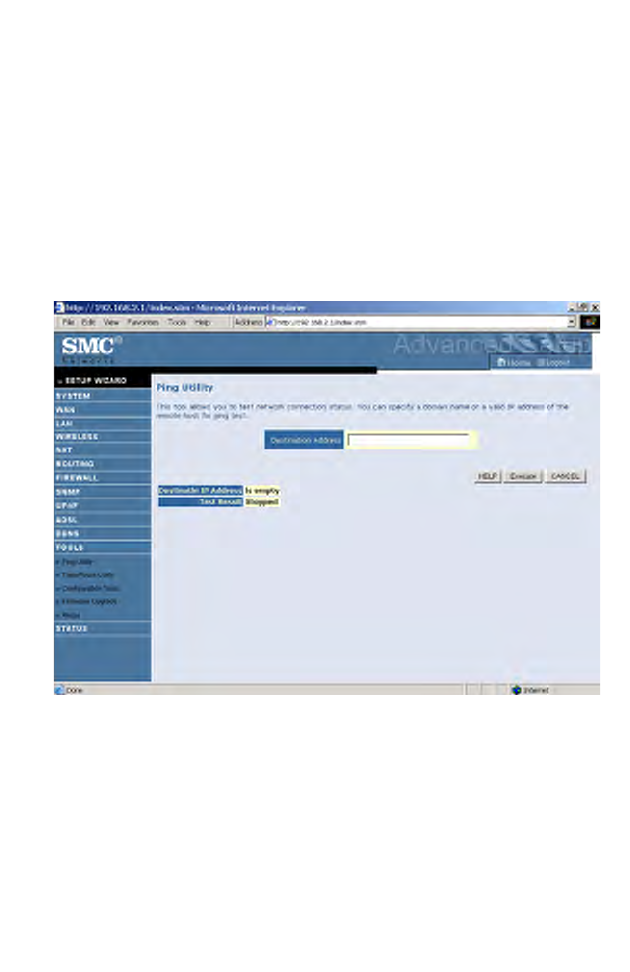
C
ONFIGURING
THE
B
ARRICADE
4-74
Tools
Use the Tools menu to ping, trace route, backup the current configuration,
restore a previously saved configuration, update firmware, and reset the
Barricade.
Ping Utility
This tool allows you to test your network connection. You can specify a
domain name or a valid IP address of the remote host for ping test.
• Enter the address in the Destination address field, then click Execute.
The result will show in the Test Result area.
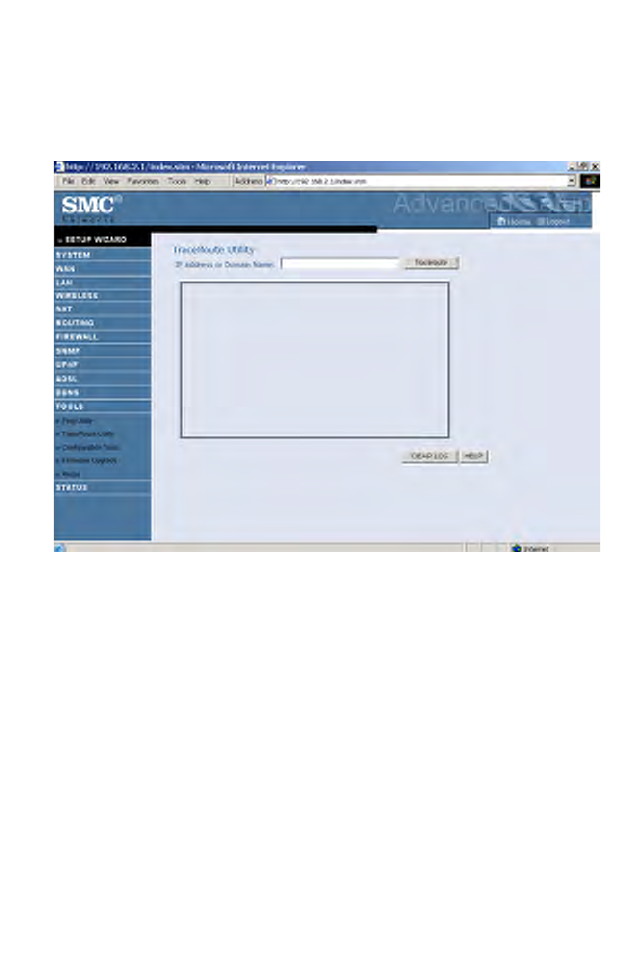
C
ONFIGURATION
PARAMETERS
4-75
Trace Route Utility
Traceroute is a TCP/IP utility which allows the user to determine the route
packets take to reach a particular host.
• Enter the information in the IP Address or Domain Name field, and
click the Traceroute button.
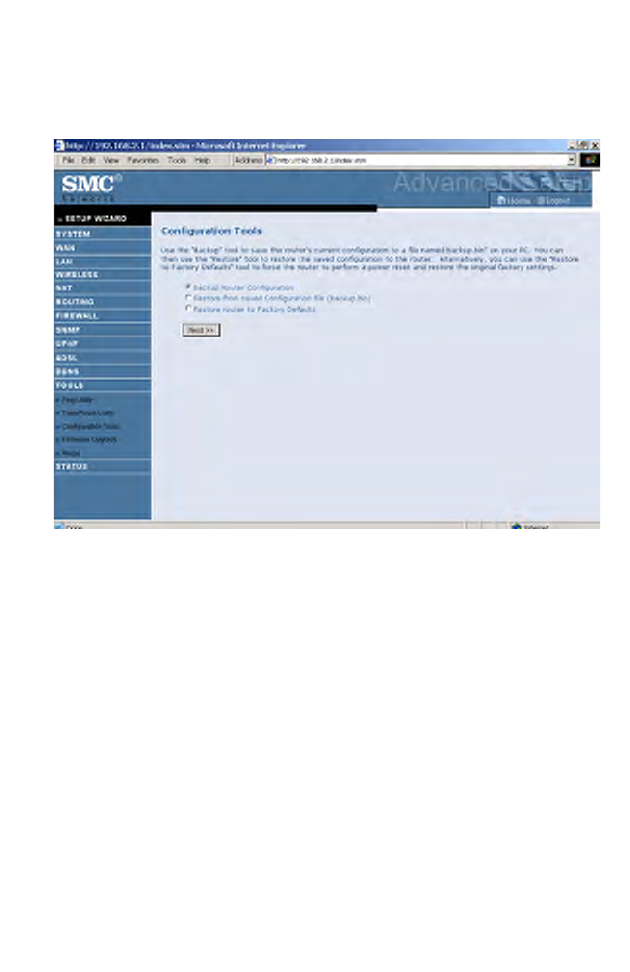
C
ONFIGURING
THE
B
ARRICADE
4-76
Configuration Tools
Choose a function and click Next.
• Backup Router Configuration: this allows you to save the Barricade’s
configuration to a file.
• Restore from saved Configuration file: this function is used to restore
the previously saved backup configuration file.
• Restore router to Factory Defaults: this resets the Barricade back to the
original default settings.

C
ONFIGURATION
PARAMETERS
4-77
Firmware Upgrade
Use this screen to update the firmware or user interface to the latest
versions.
1. Download the upgrade file from the SMC web site first, and save it to
your hard drive.
2. Then click Browse... to look for the downloaded file. Click BEGIN
UPGRADE.
Check the Status screen Information section to confirm that the upgrade
process was successful.

C
ONFIGURING
THE
B
ARRICADE
4-78
Reset
Click REBOOT ROUTER to reset the Barricade. The reset will be
complete when the power LED stops blinking.
If you perform a reset from this screen, the configurations will not be
changed back to the factory default settings.
Note: If you use the Reset button on the back panel, the Barricade
performs a power reset. If the button is pressed for over
10 seconds, all the LEDs will illuminate and the factory default
settings will be restored.

C
ONFIGURATION
PARAMETERS
4-79
Status
The Status screen displays WAN/LAN connection status, firmware, and
hardware version numbers, illegal attempts to access your network, as well
as information on DHCP clients connected to your network. The security
log may be saved to a file by clicking Save and choosing a location.
Scroll down to view more information on the Status screen.
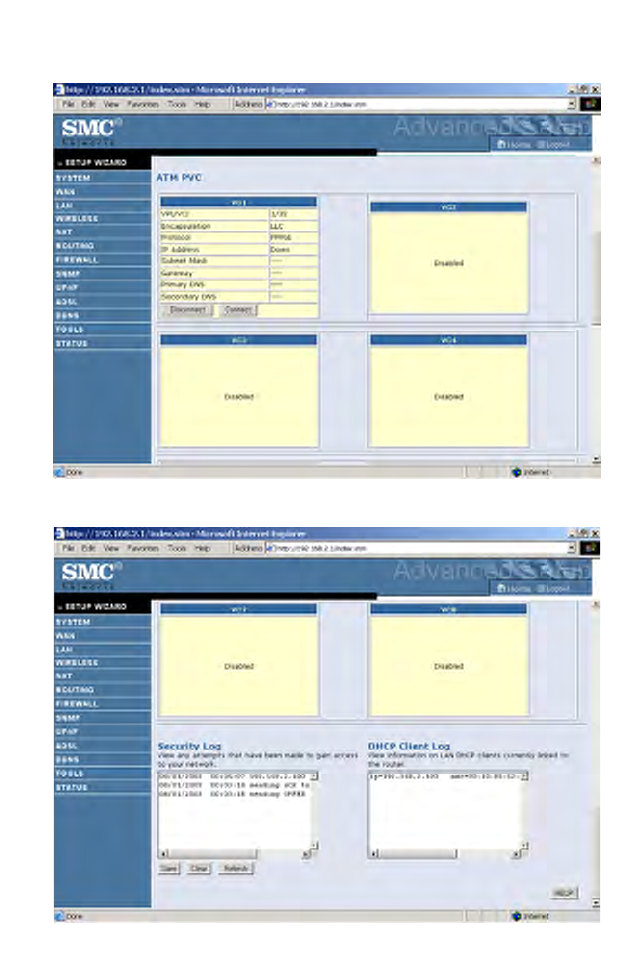
C
ONFIGURING
THE
B
ARRICADE
4-80

C
ONFIGURATION
PARAMETERS
4-81
The following items are included on the Status screen:
Parameter Description
INTERNET Displays WAN connection type and status.
Release Click on this button to disconnect from the WAN.
Renew Click on this button to establish a connection to the WAN.
GATEWAY Displays system IP settings, as well as DHCP Server and
Firewall status.
INFORMATION Displays the number of attached clients, the firmware versions,
the physical MAC address for each media interface and for the
Barricade, as well as the hardware version and serial number.
ATM PVC Displays ATM connection type and status.
Disabled The ATM connection is disabled.
Connect Click on this button to establish a connection to the ATM
connection.
Security Log Displays attempts to access your network.
Save Click on this button to save the security log file.
Clear Click on this button to delete the access log.
Refresh Click on this button to refresh the screen.
DHCP Client Log Displays information on DHCP clients on your network.

C
ONFIGURING
THE
B
ARRICADE
4-82
Finding the MAC address of a Network
Card
Windows 2000/XP
Click Start/Programs/Command Prompt. Type “ipconfig /all” and press
“ENTER”.
The MAC address is listed as the “Physical Address.”
Macintosh
Click System Preferences/Network.
The MAC address is listed as the “Ethernet Address” on the TCP/IP tab.
Linux
Run the command “/sbin/ifconfig.”
The MAC address is the value after the word “HWaddr.”

A-1
A
PPENDIX
A
T
ROUBLESHOOTING
This section describes common problems you may encounter and possible
solutions to them. The Barricade can be easily monitored through panel
indicators to identify problems.
Troubleshooting Chart
Symptom Action
LED Indicators
Power LED is
Off
• Check connections between the Barricade, the
external power supply, and the wall outlet.
• If the power indicator does not turn on when the
power cord is plugged in, you may have a problem
with the power outlet, power cord, or external power
supply. However, if the unit powers off after running
for a while, check for loose power connections, power
losses, or surges at the power outlet.
If you still cannot isolate the problem, then the
external power supply may be defective. In this case,
contact Technical Support for assistance.

T
ROUBLESHOOTING
A-2
LED Indicators
Link LED is Off • Verify that the Barricade and attached device are
powered on.
• Be sure the cable is plugged into both the Barricade
and the corresponding device.
• Verify that the proper cable type is used and that its
length does not exceed the specified limits.
• Be sure that the network interface on the attached
device is configured for the proper communication
speed and duplex mode.
• Check the adapter on the attached device and cable
connections for possible defects. Replace any
defective adapter or cable if necessary.
Network Connection Problems
Cannot ping the
Barricade from
the attached
LAN
• Verify that the IP addresses are properly configured.
For most applications, you should use the Barricade’s
DHCP function to dynamically assign IP addresses to
hosts on the attached LAN. However, if you manually
configure IP addresses on the LAN, verify that the
same network address (network component of the IP
address) and subnet mask are used for both the
Barricade and any attached LAN devices.
• Be sure the device you want to ping (or from which
you are pinging) has been configured for TCP/IP.
Troubleshooting Chart
Symptom Action

T
ROUBLESHOOTING
A-3
Management Problems
Cannot connect
using the web
browser
• Be sure to have configured the Barricade with a valid
IP address, subnet mask, and default gateway.
• Check that you have a valid network connection to the
Barricade and that the port you are using has not been
disabled.
• Check the network cabling between the management
station and the Barricade.
Forgot or lost
the password
• Press the Reset button on the rear panel (holding it
down for at least 10 seconds) to restore the factory
defaults.
Troubleshooting Chart
Symptom Action
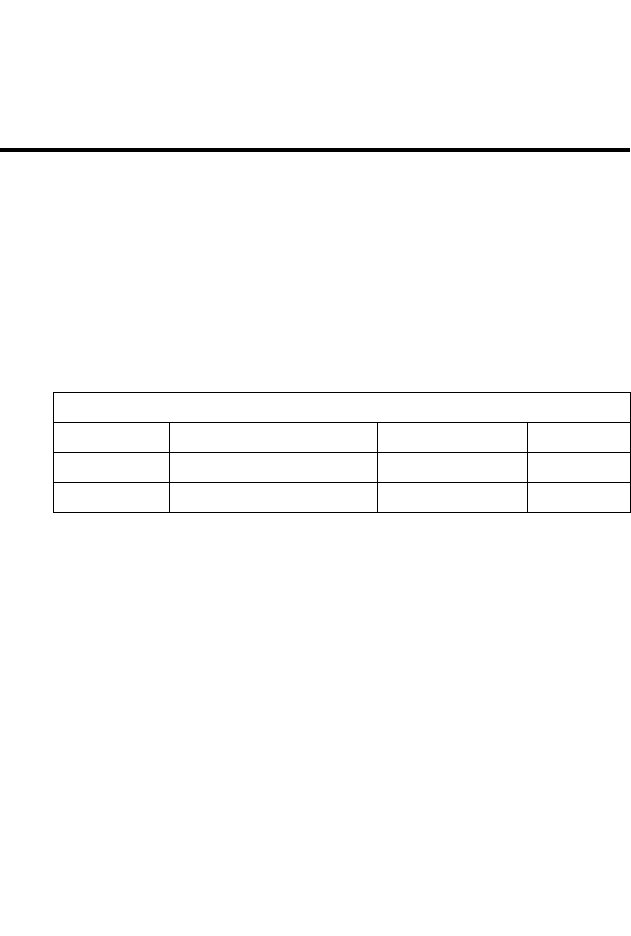
B-1
A
PPENDIX
B
C
ABLES
Ethernet Cable
Caution: DO NOT plug a phone jack connector into any RJ-45 port.
Use only twisted-pair cables with RJ-45 connectors that
conform with FCC standards.
Specifications
Wiring Conventions
For Ethernet connections, a twisted-pair cable must have two pairs of
wires. Each wire pair is identified by two different colors. For example,
one wire might be red and the other, red with white stripes. Also, an RJ-45
connector must be attached to both ends of the cable.
Cable Types and Specifications
Cable Type Max. Length Connector
10BASE-T Cat. 3, 4, 5 100-ohm UTP 100 m (328 ft) RJ-45
100BASE-TX Cat. 5 100-ohm UTP 100 m (328 ft) RJ-45

C
ABLES
B-2
Each wire pair must be attached to the RJ-45 connectors in a specific
orientation. The following figure illustrates how the pins on an Ethernet
RJ-45 connector are numbered. Be sure to hold the connectors in the same
orientation when attaching the wires to the pins.
Figure B-1. RJ-45 Ethernet Connector Pin Numbers
RJ-45 Port Connection
Use the straight-through CAT-5 Ethernet cable provided in the package to
connect the Barricade to your PC. When connecting to other network
devices such as an Ethernet switch, use the cable type shown in the
following table.
Attached Device Port Type Connecting Cable Type
MDI-X Straight-through
MDI Crossover

E
THERNET
C
ABLE
B-3
Pin Assignments
With 100BASE-TX/10BASE-T cable, pins 1 and 2 are used for
transmitting data, and pins 3 and 6 for receiving data.
Straight-Through Wiring
If the port on the attached device has internal crossover wiring (MDI-X),
then use straight-through cable.
RJ-45 Pin Assignments
Pin Number Assignment1
1Tx+
2Tx-
3Rx+
6Rx-
1: The “+” and “-” signs represent the polarity of the wires
that make up each wire pair.
Straight-Through Cable Pin Assignments
End 1 End 2
1 (Tx+) 1 (Tx+)
2 (Tx-) 2 (Tx-)
3 (Rx+) 3 (Rx+)
6 (Rx-) 6 (Rx-)

C
ABLES
B-4
Crossover Wiring
If the port on the attached device has straight-through wiring (MDI), use
crossover cable.
Crossover Cable Pin Assignments
End 1 End 2
1 (Tx+) 3 (Rx+)
2 (Tx-) 6 (Rx-)
3 (Rx+) 1 (Tx+)
6 (Rx-) 2 (Tx-)
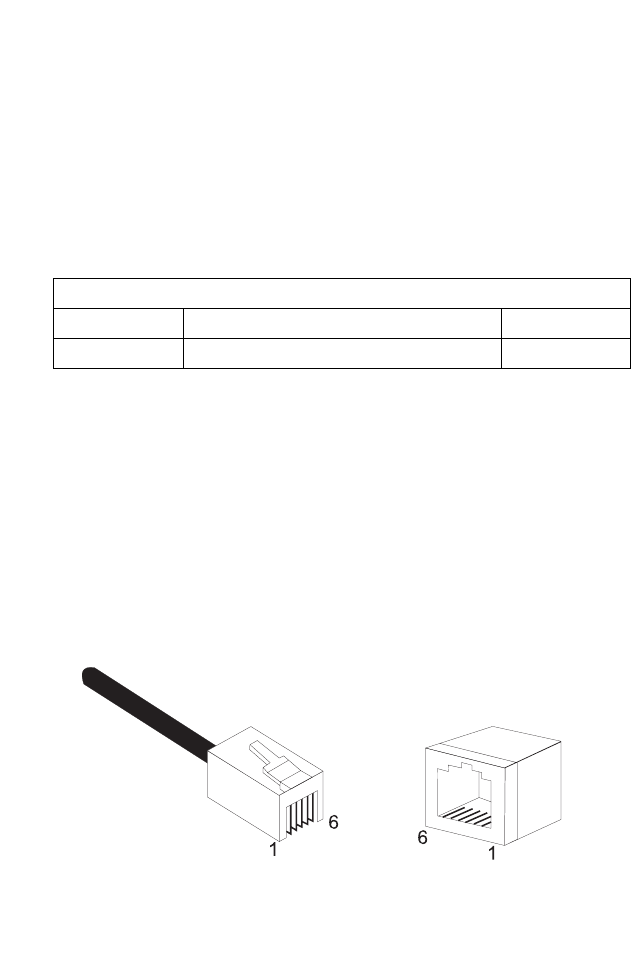
ADSL C
ABLE
B-5
ADSL Cable
Use standard telephone cable to connect the RJ-11 telephone wall outlet to
the RJ-11 ADSL port on the ADSL Router.
Caution: Do not plug a phone jack connector into an RJ-45 port.
Specifications
Wiring Conventions
For ADSL connections, a cable requires one pair of wires. Each wire is
identified by different colors. For example, one wire might be red and the
other, red with white stripes. Also, an RJ-11 connector must be attached to
both ends of the cable.
Each wire pair must be attached to the RJ-11 connectors in a specific
orientation. The following figure illustrates how the pins on the RJ-11
connector are numbered. Be sure to hold the connectors in the same
orientation when attaching the wires to the pins.
Figure B-2. RJ-11 Connector Pin Numbers
Cable Types and Specifications
Cable Type Connector
ADSL Line Standard Telephone Cable RJ-11
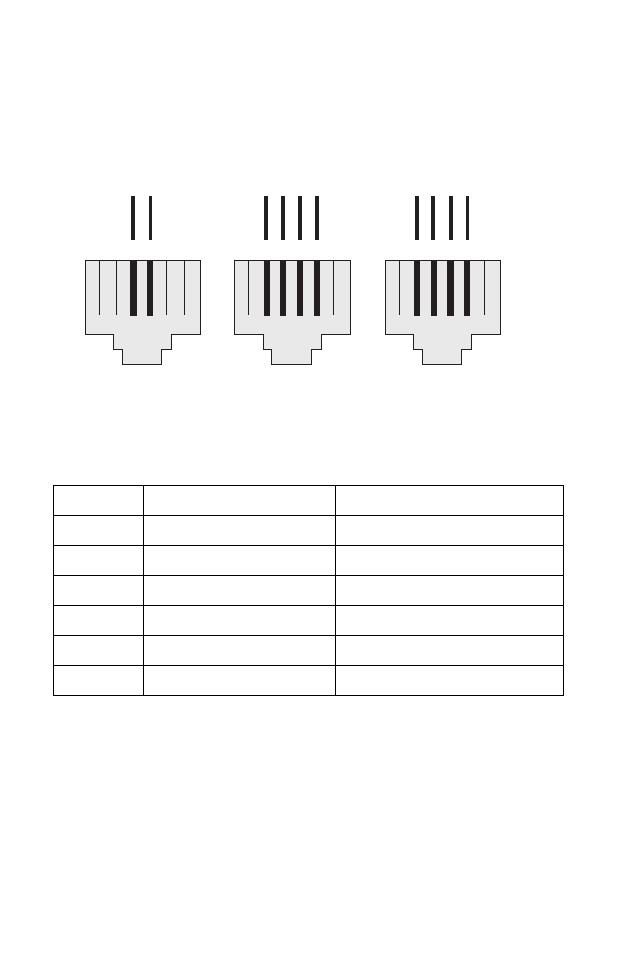
C
ABLES
B-6
Figure B-3. RJ-11 Pinouts
Pin Signal Name Wire Color
1Not used
2 Line 2 Tip Black or White/Orange
3 Line 1 Ring Red or Blue/White
4 Line 1 Tip Green or White/Blue
5 Line 2 Ring Yellow or Orange/White
6Not used
123456
Blue/White
White/Blue
R1 T1
123456
Red
Green
R1 T1 R2T2
Black
Yellow
123456
Blue/White
White/Blue
R1 T1 R2T2
White/Orange
Orange/White
6x2 Jack 6x4 Jack6x4 Jack
T = Tip R = Ring

C-1
A
PPENDIX
C
S
PECIFICATIONS
Physical Characteristics
Ports
Four 10/100Mbps RJ-45 ports
One ADSL port (RJ-11)
ADSL Features
Supports DMT line modulation
Supports Annex A Full-Rate ADSL: up to 8 Mbps downstream, up to
1 Mbps upstream (G.992.1 &T1.413, Issue 2) and ADSL2 (G.992.3) and
ADSl2+ (G.992.5)
Supports G.Lite ADSL: up to 1.5 Mbps downstream, up to 512 Kbps
upstream
Dying GASP support
ATM Features
RFC1483 Encapsulation (IP, Bridging and encapsulated routing)
PPP over ATM (LLC &VC multiplexing) (RFC2364)
Classical IP (RFC1577)
Traffic shaping (UBR, CBR)
OAM F4/F5 support
PPP over Ethernet Client
Management Features
Firmware upgrade via web based management
web based management (configuration)
Power Indicators
Event and History logging
Network Ping
Traceroute

S
PECIFICATIONS
C-2
Security Features
Password protected configuration access
User authentication (PAP/CHAP) with PPP
Firewall NAT NAPT
VPN pass through (IPSec-ESP Tunnel mode,L2TP, PPTP)
LAN Features
IEEE 802.1D (self-learning transparent Bridging)
DHCP Server
DNS Proxy
Static Routing, RIPv1 and RIP
Temperature: IEC 68-2-14
0 to 40 degrees C (Standard Operating)
-40 to 70 degree C (Non-operation)
Humidity
10% to 90% (Non-condensing)
Vibration: IEC 68-2-36, IEC 68-2-6
Shock: IEC 68-2-29
Drop: IEC 68-2-32
Dimensions: 143mm(L) x 94mm(D) x 32mm(H)
Weight: 500 g
Input Power: 15 V 0.8A
IEEE Standards
IEEE 802.3, 802.3u, 802.11g, 802.1D , 802.11 n draft
ITU G.dmt, ITU G.Handshake, ITU T.413 issue 2 - ADSL full rate
Standards Conformance Electromagnetic Compatibility
CE, ETSI, R&TTE, FCC part 15 class B & FCC part 68
Safety
EN 60950-1

S
PECIFICATIONS
C-3
Wireless Frequency Band
802.11b/g/n Radio: 2.4 GHz
USA - FCC
2412~2462 MHz (Ch1~Ch11)
Europe - ETSI
2412~2472 MHz (Ch1~Ch13)
France
2457~2472 MHz (Ch10~Ch13)
Modulation Technology: DSSS, OFDM
Operating Channels:
IEEE 802.11b compliant:
11 channels (US, Canada)
13 channels (ETSI)
4 channels (France)
IEEE 802.11g compliant:
11 channels (US, Canada)
13 channels (Europe)
IEEE draft 802.11n 20MHz compliant:
11 channels (US, Canada)
13 channels (Europe)
IEEE draft 802.11n 40MHz compliant:
7 channels (US, Canada)
9 channels (Europe)
Signal Type: DSSS/OFDM
Operating Frequency: 2.412 - 2.462GHz

SMCWBR11-G
SMC7904WBRA-N